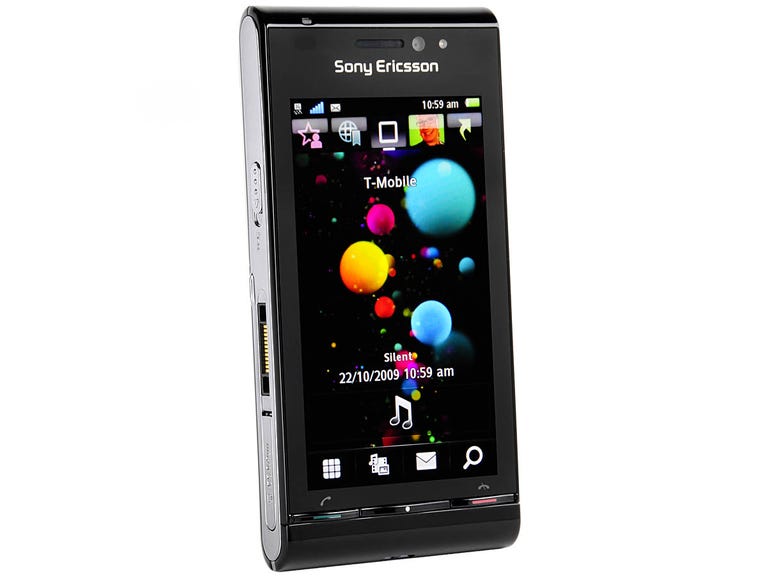 Why You Can Trust CNET
Why You Can Trust CNET Sony Ericsson Satio review: Sony Ericsson Satio
The touchscreen Satio is a decent attempt by Sony Ericsson to pack into one device all the best bits of its excellent Cyber-shot camera phones and great Walkman music phones. The camera is almost as good as a dedicated compact, and its musical output sounds like that of a stand-alone MP3 player
This review of the Sony Ericsson Satio is the story of a love that almost was, but could never be. We trembled at the Satio's spectacular photo quality and zippy shutter speed, and then recoiled at its disappointing resistive touchscreen and complicatedSymbian user interface. Our hearts melted over its excellent music quality, and then froze at the sight of its proprietary headphone jack. O Satio, Satio! Wherefore art thou, Satio?
The Good
The Bad
The Bottom Line
The Satio is available for free on a £35-per-month, 18-month contract, or you can pick it up for £500 SIM-free.
Shutter love bug
With the Satio, Sony Ericsson promised that it would take its excellent Cyber-shot
camera phones and Walkman music phones, smash them up, and rebuild them into a
super phone, the like of which has barely been dreamt possible.

One aspect of the phone that doesn't disappoint is its camera. This 12.1-megapixel monster takes the best shots we've seen from a camera phone, nearly beating our inexpensive compact camera at its own game. We found the Satio couldn't quite capture the detail of reflections and textures that we saw in our compact's photos, but it does a fantastic job of capturing a clear, clean image. Colours are slightly over-saturated, but otherwise accurate.
The Satio's default camera setting captures wide-format, 16:9,
9-megapixel images. At this setting, we were very impressed by the phone's
speed. Sliding the plastic lens cover quickly starts the camera, and there's
very little delay between pressing the shutter button and taking a photo. At
the camera's full, 12.1-megapixel resolution, we found that there was a
slight delay as the camera wrote the larger image file to the memory card. The
12.1-megapixel setting improves the clarity of the image, though, so it's worth using if you're planning to crop your photo tightly.
The Satio has an LED photo light and a xenon flash. We were very impressed by the natural-looking illumination of the flash. Our photos in dark conditions looked almost as clear and bright as our well-lit shots. The camera also recharges quickly, so you can take photos briskly one after another. That's a significant advantage over the Samsung Pixon12 M8910's slow-charging camera, for example.
Don't talk to us about 3.5mm headphone jacks
We can't say enough good things about the Satio's camera, and we were similarly
happy with its music quality. Sony Ericsson's Walkman phones rarely let us
down, and the Satio pumps out great tunes.
We listened to classical, electronic and pop MP3s on the Satio using some beautiful Audio Technica headphones, and found there was an almost imperceptible difference in sound quality compared to a SanDisk Sansa Fuze MP3 player.
Unfortunately, Sony Ericsson has saddled the Satio with a proprietary headphone jack, which it shares with the charger and USB cable. This discovery left us rending our garments and demanding ancient forms of punishment be inflicted on those responsible. We'd hoped the lovely W995 Walkman was proof that Sony Ericsson had left this concept behind forever, especially in terms of its flagship phones. But, no, it hasn't.
There's an included adaptor that adds about a metre to the cable length, so you could end up throttling yourself in time to music. The proprietary jack also means that you have to unplug the headphones every time you transfer music, since you need to plug in the USB cable to do so. But the Satio does have stereo Bluetooth, so it could stream to a set of wireless headphones.
Symbian simian
With the Satio insisting on the user carrying around a proprietary headphone
adaptor, USB cable and charger, maybe it's no wonder that it likes to punch you in the usability kidneys every chance it gets. For torturing purposes, it sports
a resistive touchscreen. This type of display requires the pressure
of a fingernail to work. The Satio even includes a stylus in the box, which
is a dark portent of how tough the screen can be to use with your fingers.
Sony Ericsson has done a brave job of covering up the rather dated-looking Symbian user interface, which we saw in all its old-school glory on the Nokia N97. The home screen is slick and glossy, with attractive icons. But there's plenty of user-interface mistakes underneath, with the keyboards being a prime example.
You have a few choices when it comes to on-screen keyboards with the Satio: an inexpressibly tiny Qwerty keyboard, which works in portrait orientation or takes up part of the screen in landscape mode, or a bigger Qwerty keyboard that only works in landscape orientation. There's also an alphanumeric keyboard, if you're feeling retro. Because the resistive touchscreen isn't that responsive, none of the keyboards are pleasurable to use, and the mini Qwerty one is insultingly small.
Another annoyance is the fact that we had to touch some items twice to get them to open. We also wanted more uniform user-interface choices. For example, the home screen has two rows of shortcuts along the top and bottom of the screen. One of the choices on the bottom row points to your media, but, after you select one of music, video or photos, the same media icon reappears at the top of the screen. It's just one example of how the user interface moves around like a belly dancer on a tilt-a-whirl. Compared to the soothing UIs of the Satio's touchscreen competitors, it feels confusing and difficult.
That said, having Symbian on-board gives the Satio many smart-phone powers. It can multitask, running several apps at once, which means that you won't have to stop Web surfing just because you want to check out a photo. But, without something like Nokia's Ovi Store, installing apps like you would on an iPhone or Android phone is difficult, with confusing messages popping up all over the place.
There are plenty of good apps already on-board, though, including Google Maps, BBC iPlayer and YouTube. There's also Wi-Fi connectivity and GPS, as well as some fun Sony Ericsson apps, like TrackID, which will identify songs and artists playing on the built-in FM radio.
Conclusion
The Sony Ericsson Satio blew us away with its photo quality, but the rest of the phone doesn't live up to its lofty goals. The irritating resistive touchscreen and confusing keyboards take the pleasure out of poking this handset, and its lack of a standard headphone jack means that, despite its excellent music quality, it can't be one of our favourite music phones.
If you're looking for the best camera phone out there, we're happy to recommend the Satio. But, for a fun-to-use touchscreen phone, seek out an iPhone or HTC Hero. For a music phone, we think you're better off with Sony Ericsson's own W995 Walkman.
Edited by Charles Kloet
